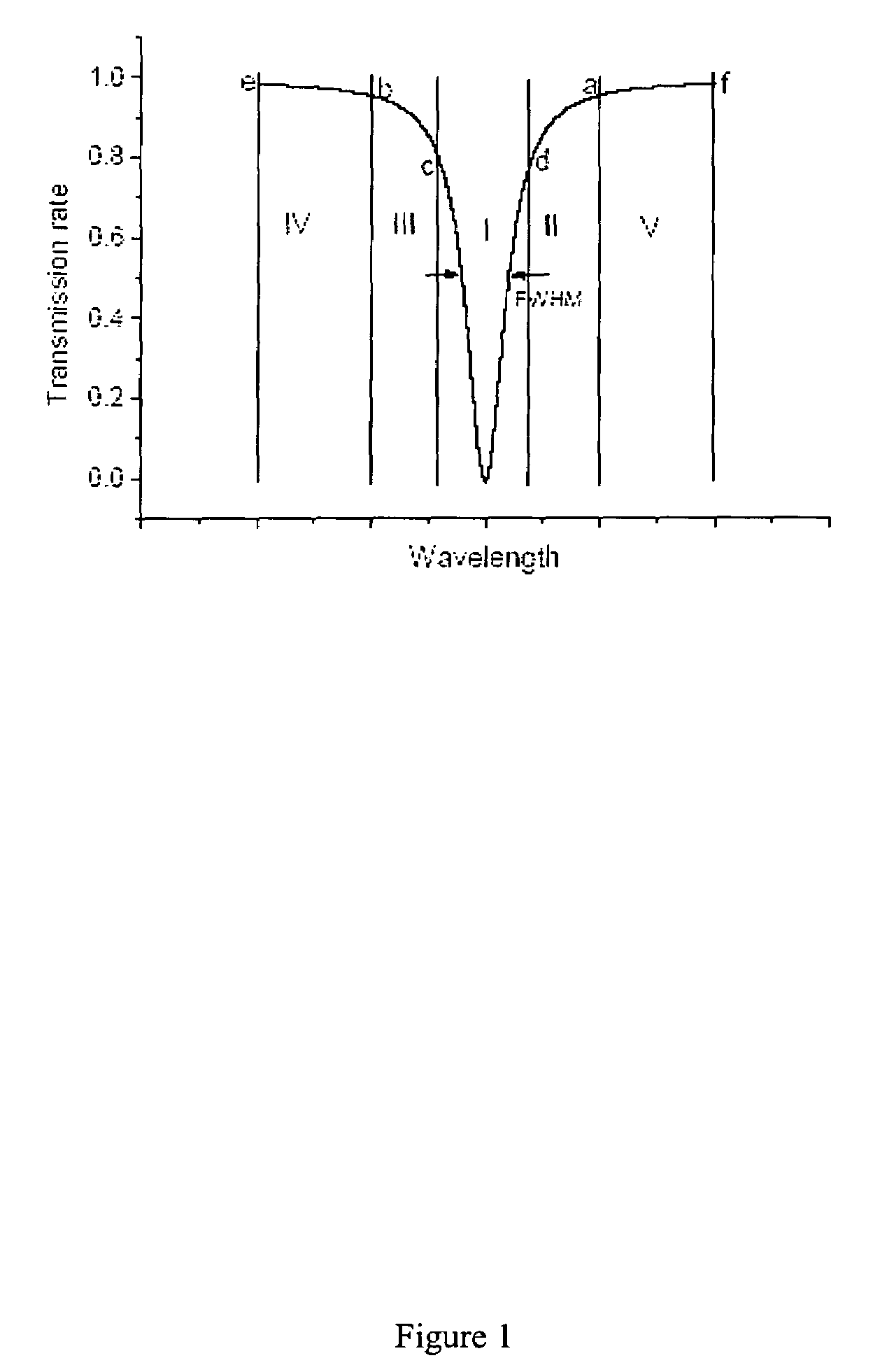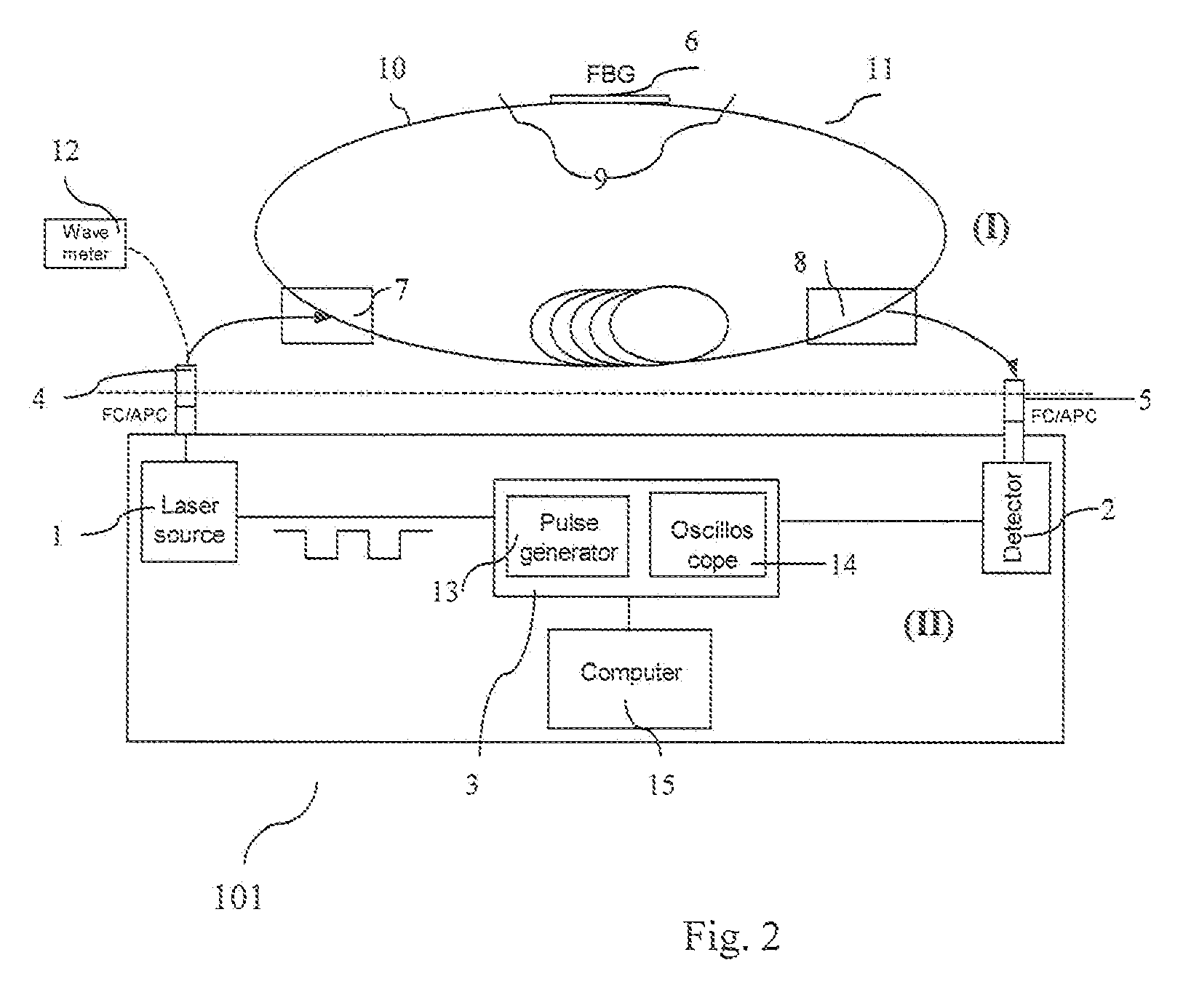Fiber-bragg grating-loop ringdown method and apparatus
a technology of ring-down loop and fiber grating, which is applied in the direction of photometry using electric radiation detectors, optical radiation measurement, instruments, etc., can solve the problems of fbg sensors, interference cavities typically coated with chemicals, and cannot survive in high temperature or chemically corroding measuring environments, etc., to achieve high accuracy/sensitivity, large measuring dynamic range, and high pressure tolerance
- Summary
- Abstract
- Description
- Claims
- Application Information
AI Technical Summary
Benefits of technology
Problems solved by technology
Method used
Image
Examples
example 1
Materials and Methods
[0067]The fiber ringdown temperature sensor device, 101 (FIG. 2), consists of two major parts: a fiber loop and an electronic control portion, 3, that includes a light source, 1, and a detector, 2. These two parts are connected together through two FC / APC fiber connectors, 4, 5, as sketched in FIG. 2. The fiber loop consists of a commercial bare fiber grating, 6, (an FBG or an LPG) that is written in a section of bare fused silica single mode fiber, 9, (O / E-land), two identical 2×1 fiber couplers, 7,8 (Lightcomm Technology), and two sections of fused silica single mode fiber, 10,11 (Corning SMF 28). The quoted split ratio in the 2-leg end of the fiber couplers, 7,8, is 1:99. The two 1-leg ends of the couplers are spliced together; and the two 99% legs of the two couplers are separately spliced with the two ends of the fiber on which a grating is written to form the fiber grating loop (FITEL S321, Optical fiber Cleaver; Ericsson 925, Fusion Splicer). The light so...
example 2
Characterization of the Ringdown Behavior of Fiber Grating Loops
[0074]FIG. 3(a) shows a typical fiber Bragg grating-loop ringdown waveform, which was recorded when the laser wavelength was tuned to 1567.30 nm, corresponding to a 0.09 dB transmission loss in the FBG. The natural logarithm of the decay waveform is fitted to a line to yield a ringdown time of 4.14 μs. The good linearity of the fitting (R2=0.99) shown in FIG. 3(b) indicates that the ringdown decay waveform follows a single exponential decay. Similar evaluations of the ringdown decay behavior observed with different light transmission losses incurred in the FBG were also performed. As long as the light transmission loss that occurred in the FBG is lower than ˜1 dB (79% transmittance), a single exponential ringdown decay waveform can be obtained. Excessive optical transmission loss in the fiber loop can result in no ringdown behavior or non-single exponential decay behavior. When the laser wavelength is properly tuned in ...
example 3
Temperature Response of the FBG Ringdown Temperature Sensor (Type I)
[0076]In the Type I sensor, an FBG was spliced with a single mode fiber to form a fiber Bragg grating loop and the FBG served as the sensing element. In the experiment, the laser wavelength was tuned to 1568.11 nm, which was located at the right-hand side of the spectral bandwidth curve, Zone V in FIG. 1. When the FBG temperature increases, the whole spectral response curve shifts to the longer wavelength direction and the relative position of the laser wavelength in the bandwidth curve equivalently shifts, i.e., from points a to d as illustrated in FIG. 1. The resultant transmission loss of the laser beam increases; therefore, the measured ringdown decreases. The FBG temperature control was achieved by using the electrical heating oven system which is described in the previous section. FIG. 4 shows a typical temperature response of the Type I sensor. The ringdown measurements at each temperature were performed for ...
PUM
 Login to View More
Login to View More Abstract
Description
Claims
Application Information
 Login to View More
Login to View More - R&D
- Intellectual Property
- Life Sciences
- Materials
- Tech Scout
- Unparalleled Data Quality
- Higher Quality Content
- 60% Fewer Hallucinations
Browse by: Latest US Patents, China's latest patents, Technical Efficacy Thesaurus, Application Domain, Technology Topic, Popular Technical Reports.
© 2025 PatSnap. All rights reserved.Legal|Privacy policy|Modern Slavery Act Transparency Statement|Sitemap|About US| Contact US: help@patsnap.com



